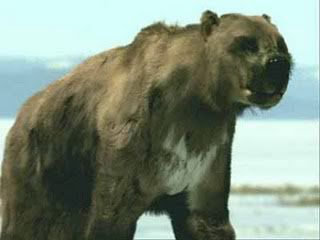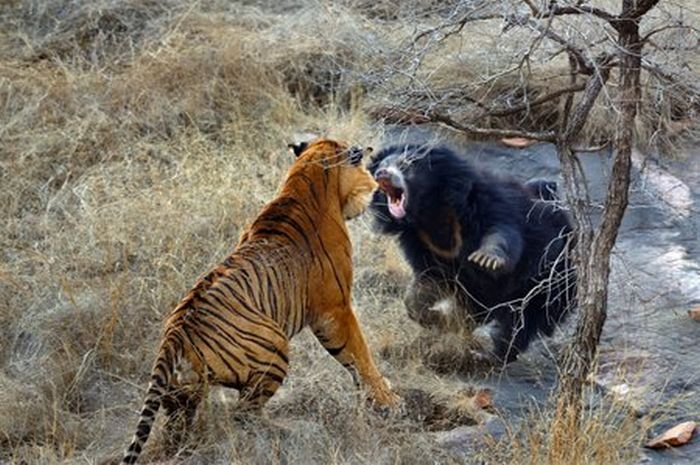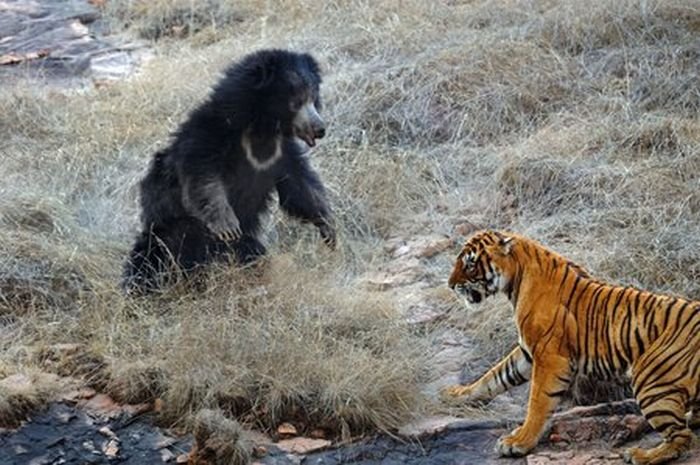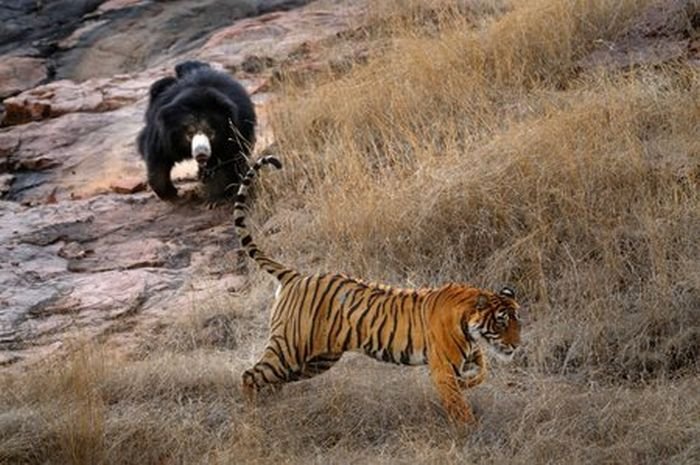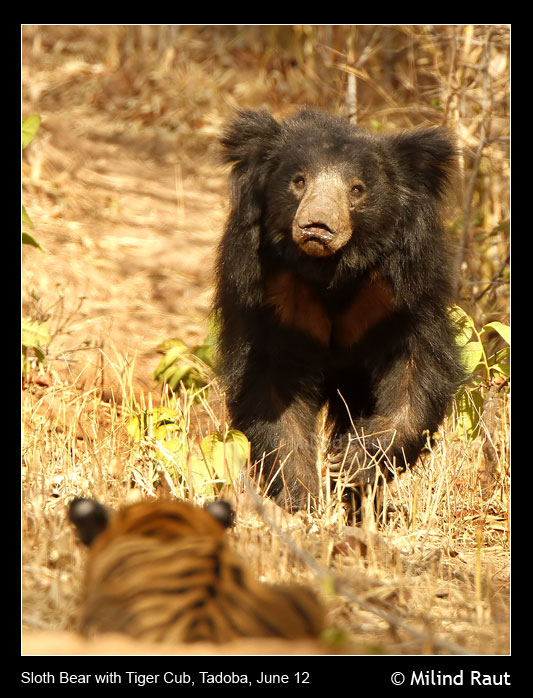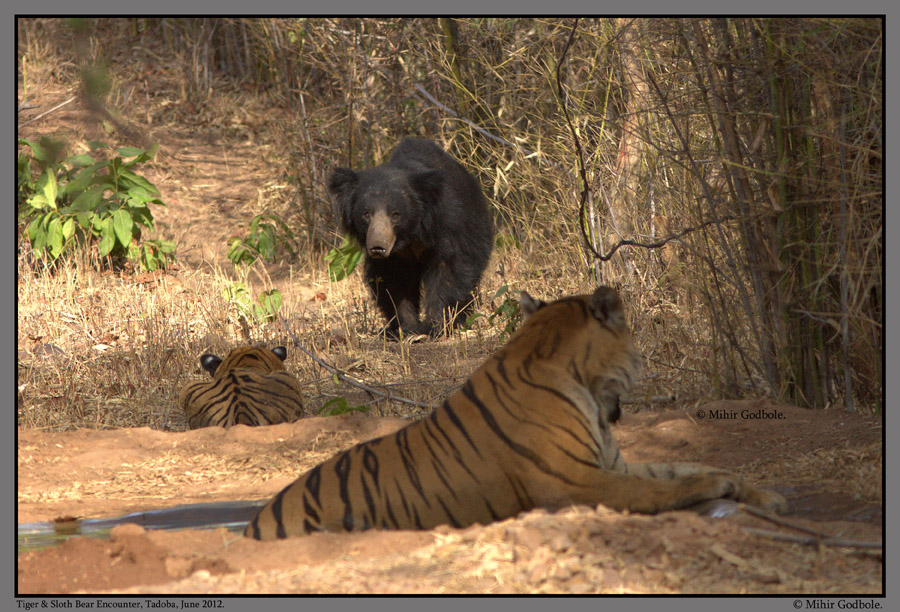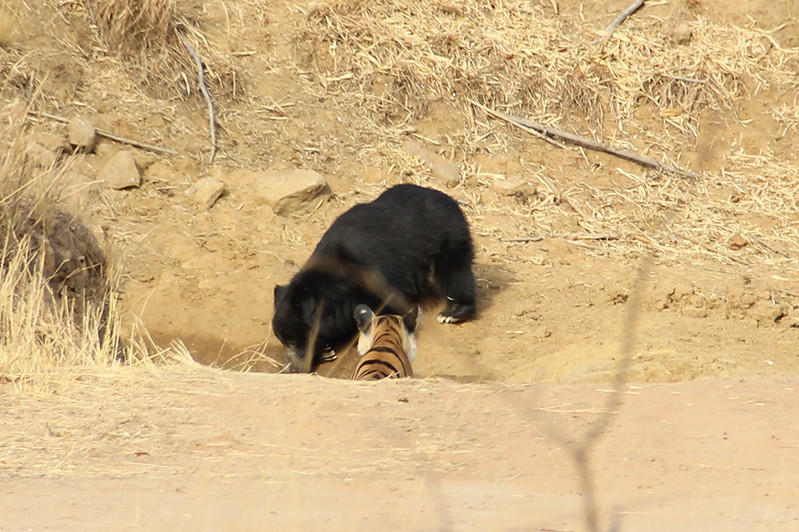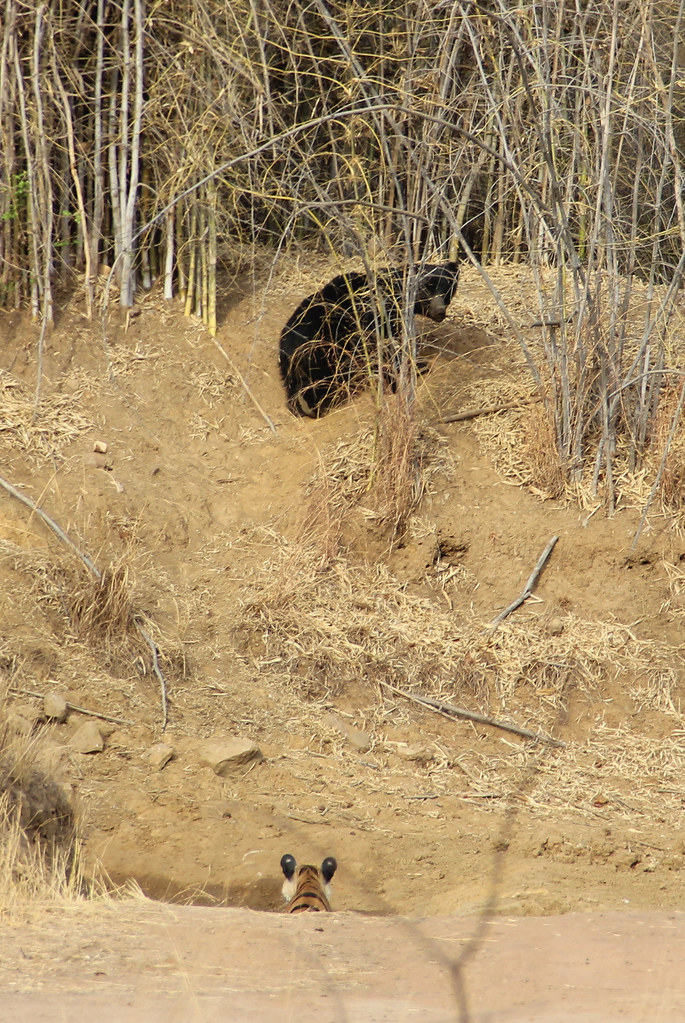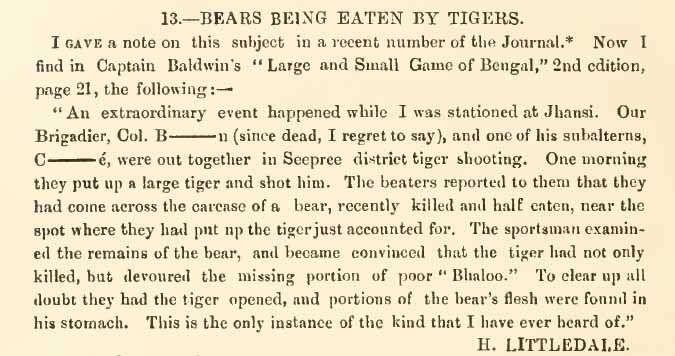There seems to be a gap or so between current research/data & older hunting accounts on sloth bear/tiger relations as it relates to successful predation.
More follow up. I think quite a few people are familiar with the following account by Valmik Thapar:
 From G.P. Sanderson, Thirteen Years Among The Wild Beasts Of India (1907):
From G.P. Sanderson, Thirteen Years Among The Wild Beasts Of India (1907):A strange example of a tiger's departing from the usual food of the Felidce, is that of a large male near Poonjoor some years ago, that is said to have killed and eaten several bears. The account of his doings in the Poonjoor jungles was given me by old Bommay Gouda, whom I have already mentioned as having lived all his life amongst tigers, bears, and elephants and as an authority whose interesting accounts of the habits and peculiarities of the occupants of the jungles could be relied on. It appears that this tiger killed several bears at different times whilst feeding, coining from behind and seizing them by the nape of the neck, and bearing them down (no pun intended), after a struggle, by his weight and strength. Towards corroborating this account some Sholagas at the other end of the hills, twenty miles away, and who knew nothing of what Bommay Gouda had told me, gave me a similar account; adding that a bear had been thus killed and partially eaten in a clearing where they were watching their crops early one morning. This was doubtless the same tiger. My Morlay trackers also told me that some years ago they surrounded a bear and her three-parts grown cub with nets in a date-grove close to which my bungalow now stands at Morlay. The bears broke through the nets, the big she being severely speared in doing so, and both got clear away to a ravine a mile distant. Next morning they were found together, dead, and the large bear partially eaten by a tiger whose marks were all around. Whether she had died of her wounds or had been killed by the tiger the men had not taken sufficient notice at the time to be able to tell me, but the cub had been killed. This was also probably the work of the same tiger. The carcass of a bear which I once shot at Yerlsariga, and which was dragged to some distance from the tents after being skinned, was partially eaten by a leopard that night, which shows that the Felidae do not always confine themselves to cattle and game.
p.273-274 (PROBABLE AGE ATTAINED BY TIGERS).
From F.C. HICKS, FORTY YEARS AMONG THE WILD ANIMALS OF INDIA (1910):In fact, there are few living things in the jungles which a bear has cause to be afraid of, except, perhaps, a tiger; but though I have known a tiger to kill and eat a bear, on the other hand, I have seen a bear stand up to a full-grown tigress and drive it right out of the jungle.
p.301 (BEAR HUNTING).
On one occasion, in 1893, while inspecting the Khatoli block in the north-east corner of the J ubbulpore District, on the borders of the Native State of Rewah, I came across the fresh tracks of a very large male tiger, and as I had little else to do just then, I amused myself by following up his tracks to see where he had gone to. While doing so, I also came across the fresh footprints of a large male bear, and the possibilities of their having met occurred to me, which lent an additional interest to my task.
Going up the bed of a somewhat wide nalla, the tracks led into a smaller one (A) to the east, and presently one of my men called out to me to come and see what he had found. On reaching the spot where he was standing in some long grass, I saw that the grass had been trampled down fiat and smeared with blood over an area of about twenty yards square, from the appearances of which it was evident that two large animals had been fighting here for a considerable period of time. To one side of this arena was another trail of blood, and on following this for a short way, we found the
remains of a full-grown bear — the head, feet, portions of the skin and bunches of hair lying about. Near by also was a pool of water, by which were the footprints of the tiger showing where he had drunk water after his meal.
The whole thing was perfectly clear: after a prolonged fight, the tiger had killed and eaten the bear — a thing which I had never known to occur before in all my experience, though, on one occasion, I saw a bear drive a tigress out of a beat.
A tiger who could kill a large male bear was obviously a beast worth trying for; but as I then had only three men with me, and the jungles were very heavy all round, I was unable to beat for him there and then.
However, I immediately sent for my buffs and tied them round the block of jungle in which I suspected the tiger to be, tying one buff at the mouth of the nalla (A) where he had killed the bear, as I felt certain he would return in the evening to contemplate the scene of his late fight.
Next morning it was this buff that was reported to have been killed by the tiger, who had dragged the carcase across the bed of the larger nalla into the triangular block of jungle to the west, in which I have killed tigers repeatedly on several occasions.
By local enquiry, I learnt that this tiger had come across from the Rewah forests, and was said to be a very dark-coloured game-killer with an exceptionally nasty temper.
Hearing that he belonged to the Rewah forests, I determined to beat him in that direction, namely, to the east; and in order to avoid beating him back over his kill, I moved further north up the bed of the nalla, and selected my post (at D) just inside the jungle with the open bed of the nalla behind me, for a tiger generally halts on reaching such an open place and so gives an opportunity for a steady shot.
Also, in view of his reputed nasty temper, I resorted to double stops, that is, placed two men together in each tree, so that they might have greater confidence in acting up to their duties. For the same reason also, I gave instructions that after standing still and shouting for five minutes, three shots were to be fired along the line of beaters, which would get the tiger on the move in the opposite direction and render it less likely to attempt a charge back over the beaters, though I knew that this would make him liable to come along at a great pace, wherein I merely accepted the lesser of the two necessary evils, but I was depending on the open bed of the nalla behind me to pull him up and so enable me to obtain a standing shot.
The beat commenced as directed, and about five minutes later there was a great hubbub among the stops to my left, intermingled with a considerable amount of roaring, and I was half afraid that the tiger had broken through. But when the noise quietened down, one of my orderlies, whom I had posted among the stops in that direction, shouted the intimation that the tiger was coming in my direction. All was then quiet for about twenty minutes, when suddenly a similar hubbub commenced among my right-wing stops. But the men all acted well, and the tiger came roaring down their line at full speed.
I first saw him when he was about two hundred yards in front, coming along with great leaping bounds like a greyhound in the long grass. Wishing to make him pull up, I took out my shrill Australian whistle, and when he was within about fifty yards of my position, I gave a piercing blast. The effect was instantaneous — the tiger pulled up short with his forelegs thrust out before him in order to arrest his impetus. The next moment I had planted a bullet in his neck, bringing him in a heap on to his nose, with the blood pouring out of his mouth. I then gave him the second barrel, and re-loaded to await the arrival of the beaters.
There was no other tiger in the beat, so when the beaters came up, I got down and enjoyed a cigar while seated on the body of my prize. He was indeed an exceptionally dark-coloured tiger, very compactly and muscularly built, without an ounce of superfluous fat, very different to a fat, lumpy cattle-lifter who would think twice before attacking a bear in the manner in which this one had done. However, he had not got off scot-free from the bear, for there was a ragged wound across one of his cheeks, where the bear had apparently given him a severe clout with his paw, as well as a bad bite through his right forearm, besides a number of minor wounds and scratches on various portions of his body — so the old bear -had died game. The wonder to me is that the tiger was bold enough to attack such an animal so persistently, for they usually give them a wide berth; it must have been sheer savageness of temperament that prompted the tiger to do this.
p.503-506 (TIGER KILLING AND EATING A BEAR).
From the publication, The Book of the Tiger by Reginald George Burton (1933):The Indian sloth bear does not escape the hunger of the Tiger, but can scarcely be numbered among his aggressive enemies, although a bear was seen to attack and begin biting a dead Tiger which had just been shot. Bears no doubt not infrequently fall victims, and I recollect the inhabitants of a village in the Melghat forest bringing to camp the skin of a large bear which they said they had killed after it had been badly mauled by a Tiger with which it had had a prolonged struggle. The skin bore tooth and claw marks, and there was no reason to doubt the truth of their story; but the bear could probably not put up much of a fight against so formidable and agile an antagonist. I have found remains of bears eaten by Tigers, and have also beaten both animals out of the same cover.
A bear was seen by Sir S. Eardley-Wilmot to gallop through a jungle and stop on reaching a road. A Tiger appeared on the road fifty yards off, and began stalking the bear, stopping when the bear stopped, and sinking on its belly when the bear moved on. This went on until only ten feet separated the two animals. Meanwhile two other Tigers came out and lay down to watch. The bear left the road and entered a patch of grass, the Tiger followed, but turned away when the bear rushed roaring at him. In another beat a wounded Tiger rushed at a bear with a cub on her back; the bear made off yelling, and another bear, where a Tiger was in the beat, howling dismally, fled to the hills.
p.106-107 (same thread, see reply #1).

